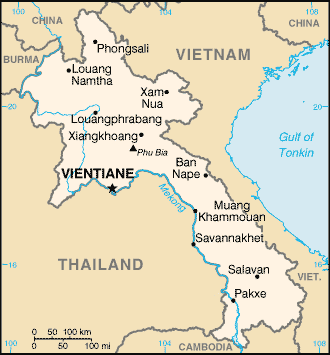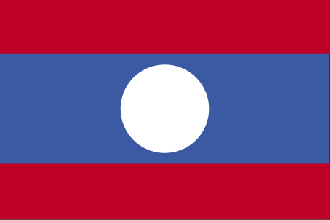
|
Laos
Background:
In 1975, the Communist Pathet Lao took control of the government, ending a
six-century-old monarchy. Initial closer ties to Vietnam and socialization were
replaced with a gradual return to private enterprise, a liberalization of
foreign investment laws, and the admission into ASEAN in 1997.
Location:
Location: Southeastern Asia, northeast of Thailand, west of Vietnam.
Area: total: 236,800 sq km, water: 6,000 sq km, land: 230,800 sq km.
Area - comparative: Slightly larger than Utah.
Land boundaries: Total: 5,083 km, border countries: Burma 235 km, Cambodia 541
km, China 423 km, Thailand 1,754 km, Vietnam 2,130 km.
Climate and Terrain:
Climate: Tropical monsoon; rainy season (May to November); dry season (December
to April).
Terrain: Mostly rugged mountains; some plains and plateaus.
Natural resources: Timber, hydropower, gypsum, tin, gold, gemstones.
People:
Population: 5,921,545.
Ethnic groups: Lao Loum (lowland) 68%, Lao Theung (upland) 22%, Lao Soung
(highland) including the Hmong ("Meo") and the Yao (Mien) 9%, ethnic
Vietnamese/Chinese 1%.
Religions: Buddhist 60%, animist and other 40% (including various Christian
denominations 1.5%).
Languages: Lao (official), French, English, and various ethnic languages.
Government:
Government type: Communist state.
Capital: Vientiane.
Independence: 19 July 1949 (from France).
Economy overview:
The government of Laos - one of the few remaining official Communist states -
began decentralizing control and encouraging private enterprise in 1986. The
results, starting from an extremely low base, were striking - growth averaged
7% in 1988-2001 except during the short-lived drop caused by the Asian
financial crisis beginning in 1997. Despite this high growth rate, Laos remains
a country with a primitive infrastructure; it has no railroads, a rudimentary
road system, and limited external and internal telecommunications. Electricity
is available in only a few urban areas. Subsistence agriculture accounts for
half of GDP and provides 80% of total employment. The economy will continue to
benefit from aid from the IMF and other international sources and from new
foreign investment in food processing and mining.
Statistics:
Telephones - main lines in use: 25,000.
Telephones - mobile cellular: 4,915.
Radio broadcast stations: AM 12, FM 1, shortwave 4.
Radios: 730,000.
Television broadcast stations: 4.
Televisions: 52,000.
Internet users: 10,000.
Railways: 0 km.
Highways: Total: 21,716 km, paved: 9,664 km, unpaved: 12,052 km.
Airports - with paved runways: 9, with unpaved runways: 42.
Return to Visiting Locations
|

